The latest Mallincam software has a really valuable new addition--live stacking that auto-aligns the captured frames into a single image. This ability to stack exposures, especially short ones, allows the capture of pinpoint stars, even if the scope's tracking is less than perfect. For example, a single, 30-second integration might show some "smearing" of stars if the mount or alignment is "less-than-perfect." But 6 x 5 second stacked integrations will show virtually no tracking errors.
I tried the setup out for the first time last night with the Mallincam DS 2.3+ with 0.5x focal reducer and Orion Skyglow imaging filter. The scope was the VRC6 on the ZEQ 25 mount. The sky was less than perfect and conditions deteriorated through the evening. By 1 am, skyglow was quite intense.
The first thing I noticed is that 6 x 5 second integrations are not the same as a single, 30-second integration (the gain settings were the same and the software was set to stack DSOs). Imaging the Dumbbell, a single 30-second exposure showed significant detail, while 6 x 5 seconds stacked did not show the nebula at all.
There were also a couple of other problems I ran across. All stacked images showed linear colored noise artifacts. Here's an example from 10 x 15-second integrations of the Dumbbell. The image shows an odd vignetting feature in the top left, along with some star distortions that must be due to a non-orthagonal imaging path. This is unrelated to the stacking and might be solvable with less aggressive focal reduction. This unprocessed image shows the linear noise artifacts clearly (click for a larger image):
I also tried a long integration of the North American Nebula. The image below is 99 x 5 seconds integration (!). The processed image follows it. I'm not sure if I captured nebulosity or skyglow in this image. Note how well the software stacks-- this is an 8.25 minute exposure. Unguided, it would be a streaky mess. But here the stars are round (apart from the vignetting artifacts mentioned above) and the depth is outstanding:
Faint streaks of glow are visible in the right, central part of the image. Processing brings them out--again, I'm not sure if this is not just skyglow, which was quite intense last night:
Notice again, the linear artifacts.
I did also have a glitch where the software reported stacked images, but did not update the output image (either in the output image counter or the actual image itself). I rebooted the computer, but that did not help. In the end, disconnecting and reconnecting the camera solved the problem,
Overall, the addition of stacking to the Mallincam Sky software is a huge improvement in capability (thanks, Rock!). I'm hoping that with some expert advice and more practice, I'll be able to get it to work for me much more effectively.





















































